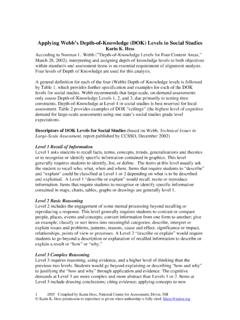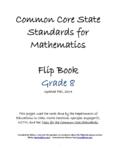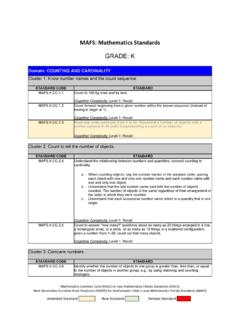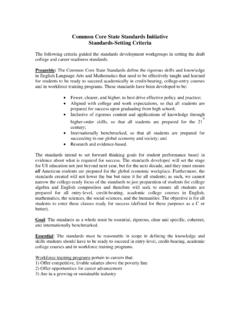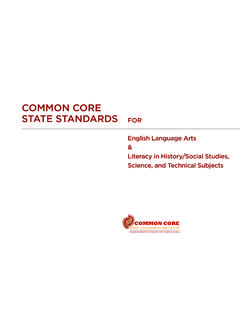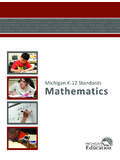Transcription of Learning Progressions Frameworks Designed for Use with The ...
1 1 Hess, Karin K., (Ed.) December 2010. Learning Progressions Frameworks Designed for Use with the Common Core State standards in mathematics K-12. National Alternate Assessment Center at the University of Kentucky and the National Center for the Improvement of Educational Assessment, Dover, (updated- ) Learning Progressions Frameworks Designed for Use with The Common Core State standards in mathematics K-12 Karin K. Hess, NCIEA, Project Director Jacqui Kearns, NAAC at UKY, NACC Principal Investigator December 31, 2010 (updated 2/24/2011) This project was funded with partial support from the Department of Education Office of Special Education Programs Grant number: H324U0400001, The National Alternate Assessment Center (NAAC) at the University of Kentucky, and The National Center for the Improvement of Educational Assessment (NCIEA), Dover, The opinions expressed herein do not necessarily reflect those of the Department of Education or offices within it.
2 Please send comments, questions, or feedback about using the draft LPFs or related instructional support modules to Karin Hess, National Center for the Improvement of Educational Assessment [ ]. 2 Hess, Karin K., (Ed.) December 2010. Learning Progressions Frameworks Designed for Use with the Common Core State standards in mathematics K-12. National Alternate Assessment Center at the University of Kentucky and the National Center for the Improvement of Educational Assessment, Dover, (updated- ) Introduction Many researchers (including developmental, educational, and cognitive psychologists), as well as curriculum and content specialists, have attempted to define and operationalize the use of Learning Progressions / Learning continua for instruction and assessment purposes over the years.
3 For example, Wilson and Bertenthal (2005) define them in terms of descriptions of the successively more sophisticated ways of thinking about an idea that follow one another as students learn; while Masters and Forster (1996) see them as a picture of the path students typically follow as they description of skills, understandings, and knowledge in the sequence in which they typically develop. Duschl, Schweingruber, and Shouse (2007) describe Learning Progressions as anchored on one end by what is known about the concepts and reasoning of students entering [for which] there now is a very extensive research base.
4 At the other end of the Learning continuum are societal expectations (values) about what society wants students to know and be able to do in the given content area. Learning Progressions propose the intermediate understandings between these anchor points that are reasonably coherent networks of ideas and contribute to building a more mature understanding. Further, they explain that often, the important precursor ideas may not look like the later ideas, yet crucially contribute to their construction (Hess, 2008, p. 2). A focus on research and Learning : This project has attempted to describe research-based pathways for Learning that can guide lesson planning, and curriculum and assessment development K-12.
5 Our working definition of Learning Progressions is based on four interrelated guiding principles (Hess, 2008). It is the research base (how understanding of the core concepts and essential skills of mathematics typically develop over time when supported by high quality, targeted instruction), not standards that have driven this work. We have not simply rearranged the standards . It is our hope that with a better understanding of how to apply the research to classroom practice (instruction and assessment) teachers will be better able to prepare all students to be productive citizens in the 21st century world beyond high school.
6 Four Interrelated Guiding Principles of Learning Progressions (LPs) LPs are developed (and refined) using available research and evidence LPs have clear binding threads that articulate the essential core concepts and processes of a discipline (sometimes called the big ideas of the discipline) LPs articulate movement toward increased understanding (meaning deeper, broader, more sophisticated understanding) LPs go hand-in-hand with well- Designed and aligned assessments 3 Hess, Karin K., (Ed.) December 2010. Learning Progressions Frameworks Designed for Use with the Common Core State standards in mathematics K-12.
7 National Alternate Assessment Center at the University of Kentucky and the National Center for the Improvement of Educational Assessment, Dover, (updated- ) A conceptual framework: The use of the term framework in this document is similar to the National Research Council (2010) use, meaning that this Learning progression framework (LPF) presents a broad description of the essential content and general sequencing for student Learning and skill development, but not at the level of detail of grade-specific curriculum. As with the NRC approach, this framework is committed to the notion of Learning as an ongoing developmental progression.
8 It is Designed to help children continually build on, and revise their knowledge and abilities, starting from initial conceptions about how the world works and curiosity about what they see around them (NRC, 2010, Ch1-p2). This document is intended to present a coherent vision for mathematics Learning and act as a first step in curriculum development or test design. We think it can serve as a guide to curriculum designers, assessment developers, state and district administrators, those responsible for teacher education, and teachers working in both general and special education classrooms. As a matter of fact, we hope that this document will encourage more teaming and planning at the school, district, and state levels between general and special education providers.
9 The Learning Progressions Frameworks developed in mathematics , language arts, and science for this project build upon the concept of the Assessment Triangle, first presented by Pellegrino, Chudowsky, and Glaser in Knowing What Students Know/KWSK (NRC, 2001). The assessment triangle explicates three key elements underlying any assessment: a model of student cognition and Learning in the domain, a set of beliefs about the kinds of observation that will provide evidence of students competencies, and an interpretation process for making sense of the evidence (NRC, 2001, p. 44). KWSK uses the heuristic of an assessment triangle to illustrate the relationships among Learning models, assessment methods, and inferences one can draw from the observations made about what students truly know and can do (Hess, Burdge, & Clayton, 2011).
10 The LPF Frameworks offer a coherent starting point for thinking about how students develop competence in an academic domain and how to observe and interpret the Learning as it unfolds. The Assessment Triangle (NRC, 2001, p. 44) Observation: A set of specifications for assessment tasks that will elicit illuminating responses from students Interpretation: The methods and analytic tools used to make sense of and reason from the assessment observations/evidence Cognition: Beliefs about how humans represent information and develop competence in a particular academic domain 4 Hess, Karin K., (Ed.) December 2010.


